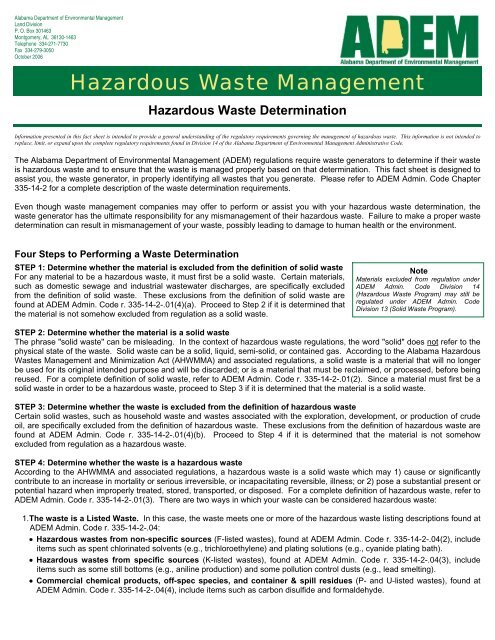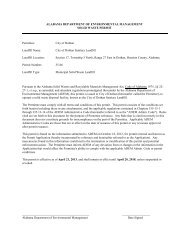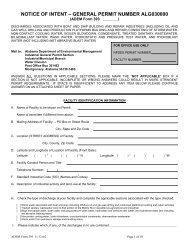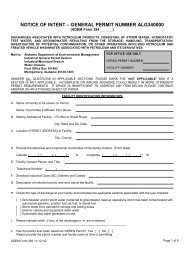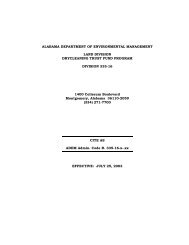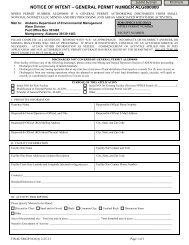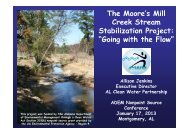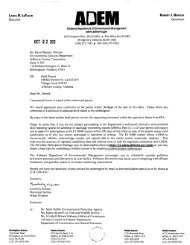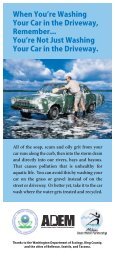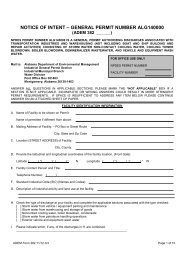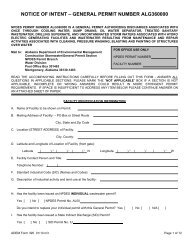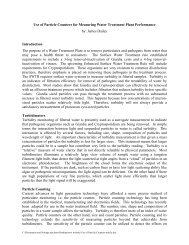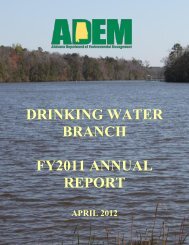Hazardous Waste Program - Alabama Department of Environmental ...
Hazardous Waste Program - Alabama Department of Environmental ...
Hazardous Waste Program - Alabama Department of Environmental ...
Create successful ePaper yourself
Turn your PDF publications into a flip-book with our unique Google optimized e-Paper software.
<strong>Alabama</strong> <strong>Department</strong> <strong>of</strong> <strong>Environmental</strong> ManagementLand DivisionP. O. Box 301463Montgomery, AL 36130-1463Telephone 334-271-7730Fax 334-279-3050October 2006<strong>Hazardous</strong> <strong>Waste</strong> Management<strong>Hazardous</strong> <strong>Waste</strong> DeterminationInformation presented in this fact sheet is intended to provide a general understanding <strong>of</strong> the regulatory requirements governing the management <strong>of</strong> hazardous waste. This information is not intended toreplace, limit, or expand upon the complete regulatory requirements found in Division 14 <strong>of</strong> the <strong>Alabama</strong> <strong>Department</strong> <strong>of</strong> <strong>Environmental</strong> Management Administrative Code.The <strong>Alabama</strong> <strong>Department</strong> <strong>of</strong> <strong>Environmental</strong> Management (ADEM) regulations require waste generators to determine if their wasteis hazardous waste and to ensure that the waste is managed properly based on that determination. This fact sheet is designed toassist you, the waste generator, in properly identifying all wastes that you generate. Please refer to ADEM Admin. Code Chapter335-14-2 for a complete description <strong>of</strong> the waste determination requirements.Even though waste management companies may <strong>of</strong>fer to perform or assist you with your hazardous waste determination, thewaste generator has the ultimate responsibility for any mismanagement <strong>of</strong> their hazardous waste. Failure to make a proper wastedetermination can result in mismanagement <strong>of</strong> your waste, possibly leading to damage to human health or the environment.Four Steps to Performing a <strong>Waste</strong> DeterminationSTEP 1: Determine whether the material is excluded from the definition <strong>of</strong> solid wasteFor any material to be a hazardous waste, it must first be a solid waste. Certain materials,such as domestic sewage and industrial wastewater discharges, are specifically excludedfrom the definition <strong>of</strong> solid waste. These exclusions from the definition <strong>of</strong> solid waste arefound at ADEM Admin. Code r. 335-14-2-.01(4)(a). Proceed to Step 2 if it is determined thatthe material is not somehow excluded from regulation as a solid waste.NoteMaterials excluded from regulation underADEM Admin. Code Division 14(<strong>Hazardous</strong> <strong>Waste</strong> <strong>Program</strong>) may still beregulated under ADEM Admin. CodeDivision 13 (Solid <strong>Waste</strong> <strong>Program</strong>).STEP 2: Determine whether the material is a solid wasteThe phrase "solid waste" can be misleading. In the context <strong>of</strong> hazardous waste regulations, the word "solid" does not refer to thephysical state <strong>of</strong> the waste. Solid waste can be a solid, liquid, semi-solid, or contained gas. According to the <strong>Alabama</strong> <strong>Hazardous</strong><strong>Waste</strong>s Management and Minimization Act (AHWMMA) and associated regulations, a solid waste is a material that will no longerbe used for its original intended purpose and will be discarded; or is a material that must be reclaimed, or processed, before beingreused. For a complete definition <strong>of</strong> solid waste, refer to ADEM Admin. Code r. 335-14-2-.01(2). Since a material must first be asolid waste in order to be a hazardous waste, proceed to Step 3 if it is determined that the material is a solid waste.STEP 3: Determine whether the waste is excluded from the definition <strong>of</strong> hazardous wasteCertain solid wastes, such as household waste and wastes associated with the exploration, development, or production <strong>of</strong> crudeoil, are specifically excluded from the definition <strong>of</strong> hazardous waste. These exclusions from the definition <strong>of</strong> hazardous waste arefound at ADEM Admin. Code r. 335-14-2-.01(4)(b). Proceed to Step 4 if it is determined that the material is not somehowexcluded from regulation as a hazardous waste.STEP 4: Determine whether the waste is a hazardous wasteAccording to the AHWMMA and associated regulations, a hazardous waste is a solid waste which may 1) cause or significantlycontribute to an increase in mortality or serious irreversible, or incapacitating reversible, illness; or 2) pose a substantial present orpotential hazard when improperly treated, stored, transported, or disposed. For a complete definition <strong>of</strong> hazardous waste, refer toADEM Admin. Code r. 335-14-2-.01(3). There are two ways in which your waste can be considered hazardous waste:1. The waste is a Listed <strong>Waste</strong>. In this case, the waste meets one or more <strong>of</strong> the hazardous waste listing descriptions found atADEM Admin. Code r. 335-14-2-.04:• <strong>Hazardous</strong> wastes from non-specific sources (F-listed wastes), found at ADEM Admin. Code r. 335-14-2-.04(2), includeitems such as spent chlorinated solvents (e.g., trichloroethylene) and plating solutions (e.g., cyanide plating bath).• <strong>Hazardous</strong> wastes from specific sources (K-listed wastes), found at ADEM Admin. Code r. 335-14-2-.04(3), includeitems such as some still bottoms (e.g., aniline production) and some pollution control dusts (e.g., lead smelting).• Commercial chemical products, <strong>of</strong>f-spec species, and container & spill residues (P- and U-listed wastes), found atADEM Admin. Code r. 335-14-2-.04(4), include items such as carbon disulfide and formaldehyde.
<strong>Hazardous</strong> <strong>Waste</strong> DeterminationPage 2 <strong>of</strong> 22. The waste is a Characteristic <strong>Waste</strong>. In this case, the waste exhibits one or more <strong>of</strong> the four characteristics <strong>of</strong> hazardouswaste found at ADEM Admin. Code r. 335-14-2-.03:• Ignitable wastes (D001), found at ADEM Admin. Code r. 335-14-2-.03(2), are liquid wastes with a flash point less than140°F; solid wastes that ignite spontaneously and burn vigorously; or ignitable compressed gases or oxidizers as defined byUSDOT (e.g., solvents, paints).• Corrosive wastes (D002), found at ADEM Admin. Code r. 335-14-2-.03(3), are acids with a pH <strong>of</strong> 2 or less; caustics with apH <strong>of</strong> 12.5 or more; or liquids that corrode steel at a rate greater than ¼ inch per year (e.g., strippers, cleaners).• Reactive wastes (D003), found at ADEM Admin. Code r. 335-14-2-.03(4), explode; react violently with water; form toxicgases when exposed to water; release significant quantities <strong>of</strong> cyanide- or sulfide-containing gases; or are otherwiseunstable (e.g., explosives, reactive metals).• Toxic wastes (D004 through D043), found at ADEM Admin. Code r. 335-14-2-.03(5), contain at least one <strong>of</strong> 40 specifiedconstituents (e.g., lead, benzene, chlordane) that leach out <strong>of</strong> the waste at levels that are hazardous.Note: Once you have determined the regulatory status (excluded from regulation, solid waste, or hazardous waste) <strong>of</strong> your waste, youshould periodically re-evaluate that status to verify that it is still correct. You should document the initial determination, as well as anysubsequent determinations, in accordance with ADEM Admin. Code r. 335-14-3-.04(1)(c).Generator Knowledge vs. <strong>Waste</strong> Sampling and AnalysisADEM Admin. Code r. 335-14-3-.01(2) allows the use <strong>of</strong> "generator knowledge" in the hazardous waste determination process.Generator knowledge, or process knowledge, may consist <strong>of</strong> information about the waste obtained from existing published wasteanalysis data or studies conducted on the hazardous waste generated by processes identical or similar to those utilized in youroperation. In general, identification <strong>of</strong> listed wastes can be accomplished by comparing the specific process that generated thewaste to those processes described in the lists found at ADEM Admin. Code r. 335-14-2-.04.Documentation used to support generator knowledge mayinclude, but is not limited to, material safety data sheets(MSDS) or similar documents and/or a thorough processdescription, including data on all raw materials used. Youmust maintain detailed documentation that clearlydemonstrates the information used to identify the waste.NoteManufacturers and suppliers are only required to list constituents on an MSDSthat comprise 1% or more <strong>of</strong> the material. This level <strong>of</strong> information may not beadequate to determine the constituent levels in the wastes to be characterized.For this reason, an MSDS should merely be viewed as a supporting documentand not the sole means <strong>of</strong> documenting generator knowledge.When determining whether a waste exhibits one <strong>of</strong> the characteristics found at ADEM Admin. Code r. 335-14-2-.03, sampling andanalysis may be necessary. Sampling and analysis <strong>of</strong> the waste is more accurate and defensible than the other option <strong>of</strong>generator knowledge. Procedures and equipment for obtaining and analyzing samples are described in the <strong>Environmental</strong>Protection Agency (EPA) publication SW-846, entitled Test Methods for Evaluating Solid <strong>Waste</strong>, Physical/Chemical Methods.It is recommended that you prepare a sampling and analysis plan before collecting and testing waste samples. Again, EPA'sSW-846 (Chapters 1 and 9) is a good source <strong>of</strong> information regarding sampling and analysis. A "representative sample" is asample <strong>of</strong> a universe that can be expected to exhibit the average properties <strong>of</strong> the universe. A representative sample is requiredto properly characterize a waste stream using sampling and analysis. Chapter 9 <strong>of</strong> EPA's SW-846 contains information regardingmethods for statistical determination <strong>of</strong> a valid number <strong>of</strong> samples, recommended sampling methods, sampling strategies, andapplicable sampling equipment.In making your hazardous waste determination, be sure to include all applicable hazardous waste numbers (whether it is a listedhazardous waste, characteristic hazardous waste, or a combination <strong>of</strong> both). Documenting both the generator knowledge andanalytical data is essential. All information used to make a hazardous waste determination must be maintained for at least threeyears after the waste is last sent for treatment, storage, or disposal.For further information, contact: ADEM Ombudsman 800-533-ADEM (2336) <strong>Hazardous</strong> <strong>Waste</strong> Compliance Inspectors 334-271-7730 Outreach Branch (to order regulations) 334-271-7718 ADEM Administrative Code Division 14 ADEM Guidance SW-846 On-Linehttp://www.adem.alabama.gov/Regulations/regulations.htmhttp://www.adem.alabama.gov/LandDivision/Guidance/guidance.htmhttp://www.epa.gov/epaoswer/hazwaste/test/main.htm


